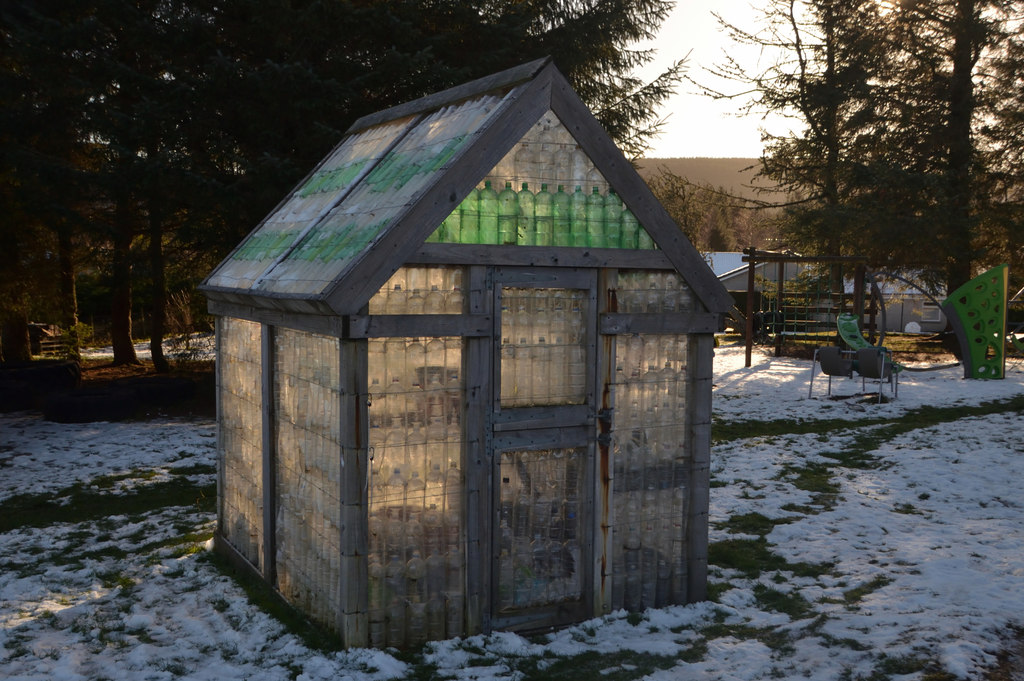Upcycling

|
| This greenhouse project at the Edderton Primary School in the Scottish Highlands, was constructed from a timber frame, with wall panels made from empty plastic drinks bottles. |
Upcycling is the creative reuse of existing materials to form something new. This technique often preserves some of the qualities or characteristics of the original materials. It is sometimes associated with social enterprises or do-it-yourself activities in communities.
Upcycling projects vary significantly in complexity and variety of materials. Unlike recycling, upcycling does not break the product down to its raw materials for repurposing. Instead, it transforms the existing materials into something else, ideally improving their appearance and purpose as a result of the process. While the overall improvement may be subjective, this idea of improvement is the “up” aspect of upcycling. Sometimes materials can be taken from a low-value use and upcycled to a higher value use.
In terms of buildings and construction, upcycling can be used to revitalise existing buildings that might otherwise be targeted for demolition. If the fundamental foundations, and other key elements of the buildings are sound, then they may be suitable for upcycling.
The benefits of upcycling buildings can include:
- Reducing the amount of waste sent to landfill.
- Conserving resources and reducing pollution.
- Reducing production costs.
- Encouraging creativity.
[edit] Related articles on Designing Buildings
- Ashby company breathes new life into 19th century hospital site.
- Conservation Professional Practice Principles.
- Quantification of construction materials in existing buildings (material intensity).
- Recycling explained.
- Retrofit measures for historic buildings and cities.
- Saltaire world heritage site.
- Sustainability in building design and construction.
- Upcycling buildings.
- Upgrade.
Featured articles and news
RTPI leader to become new CIOB Chief Executive Officer
Dr Victoria Hills MRTPI, FICE to take over after Caroline Gumble’s departure.
Social and affordable housing, a long term plan for delivery
The “Delivering a Decade of Renewal for Social and Affordable Housing” strategy sets out future path.
A change to adoptive architecture
Effects of global weather warming on architectural detailing, material choice and human interaction.
The proposed publicly owned and backed subsidiary of Homes England, to facilitate new homes.
How big is the problem and what can we do to mitigate the effects?
Overheating guidance and tools for building designers
A number of cool guides to help with the heat.
The UK's Modern Industrial Strategy: A 10 year plan
Previous consultation criticism, current key elements and general support with some persisting reservations.
Building Safety Regulator reforms
New roles, new staff and a new fast track service pave the way for a single construction regulator.
Architectural Technologist CPDs and Communications
CIAT CPD… and how you can do it!
Cooling centres and cool spaces
Managing extreme heat in cities by directing the public to places for heat stress relief and water sources.
Winter gardens: A brief history and warm variations
Extending the season with glass in different forms and terms.
Restoring Great Yarmouth's Winter Gardens
Transforming one of the least sustainable constructions imaginable.
Construction Skills Mission Board launch sector drive
Newly formed government and industry collaboration set strategy for recruiting an additional 100,000 construction workers a year.
New Architects Code comes into effect in September 2025
ARB Architects Code of Conduct and Practice available with ongoing consultation regarding guidance.
Welsh Skills Body (Medr) launches ambitious plan
The new skills body brings together funding and regulation of tertiary education and research for the devolved nation.
Paul Gandy FCIOB announced as next CIOB President
Former Tilbury Douglas CEO takes helm.
UK Infrastructure: A 10 Year Strategy. In brief with reactions
With the National Infrastructure and Service Transformation Authority (NISTA).






















